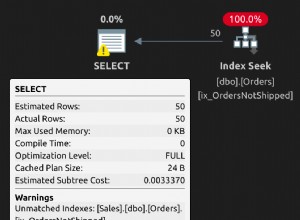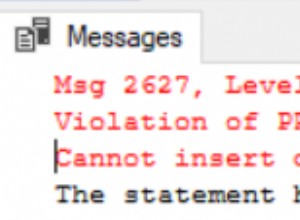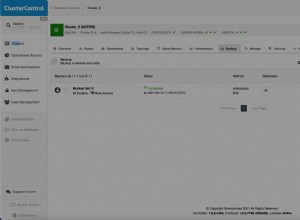Tôi giả sử điều này sẽ dẫn đến "Mảng kết hợp rỗng" được in. Giả định đó là sai đối với mảng kết hợp. Chúng tồn tại khi được khai báo, nhưng trống rỗng. Nó sẽ đúng cho các kiểu tập hợp PL / SQL khác:
So sánh:
SQL> declare
2 type varchar2_100_aa is table of varchar2(100) index by binary_integer;
3 test varchar2_100_aa;
4 begin
5 test(1) := 'Hello';
6 dbms_output.put_line(test(1));
7 end;
8 /
Hello
PL/SQL procedure successfully completed.
SQL> declare
2 type varchar2_100_va is varray(100) of varchar2(100);
3 test varchar2_100_va;
4 begin
5 test(1) := 'Hello';
6 dbms_output.put_line(test(1));
7 end;
8 /
declare
*
ERROR at line 1:
ORA-06531: Reference to uninitialized collection
ORA-06512: at line 5
Mảng biến được thực hiện đúng cách:
SQL> declare
2 type varchar2_100_va is varray(10) of varchar2(100);
3 test varchar2_100_va;
4 begin
5 test := varchar2_100_va(); -- not needed on associative array
6 test.extend; -- not needed on associative array
7 test(1) := 'Hello';
8 dbms_output.put_line(test(1));
9 end;
10 /
Hello
PL/SQL procedure successfully completed.
Vì mảng kết hợp trống nên first và last là null, đó là lý do tại sao ví dụ thứ hai của bạn dẫn đến ORA-06502: PL/SQL: Numeric or value error :
SQL> declare
2 type varchar2_100_aa is table of varchar2(100) index by binary_integer;
3 test varchar2_100_aa;
4 begin
5 dbms_output.put_line(test.count);
6 dbms_output.put_line(coalesce(to_char(test.first), 'NULL'));
7 dbms_output.put_line(coalesce(to_char(test.last), 'NULL'));
8 test(1) := 'Hello';
9 dbms_output.new_line;
10 dbms_output.put_line(test.count);
11 dbms_output.put_line(coalesce(to_char(test.first), 'NULL'));
12 dbms_output.put_line(coalesce(to_char(test.last), 'NULL'));
13 end;
14 /
0
NULL
NULL
1
1
1
PL/SQL procedure successfully completed.
CHỈNH SỬA Cũng lưu ý rằng các mảng kết hợp có thể thưa thớt. Lặp lại các số giữa first và last sẽ đưa ra một ngoại lệ cho bất kỳ bộ sưu tập nào bị thưa thớt. Thay vào đó, hãy sử dụng first và next
như vậy:(Last và prev để lặp lại hướng khác.)
SQL> declare
2 type varchar2_100_aa is table of varchar2(100) index by binary_integer;
3 test varchar2_100_aa;
4 i binary_integer;
5 begin
6 test(1) := 'Hello';
7 test(100) := 'Good bye';
8 dbms_output.put_line(test.count);
9 dbms_output.put_line(coalesce(to_char(test.first), 'NULL'));
10 dbms_output.put_line(coalesce(to_char(test.last), 'NULL'));
11 dbms_output.new_line;
12 --
13 i := test.first;
14 while (i is not null) loop
15 dbms_output.put_line(to_char(i, '999') || ' - ' || test(i));
16 i := test.next(i);
17 end loop;
18 end;
19 /
2
1
100
1 - Hello
100 - Good bye
PL/SQL procedure successfully completed.




